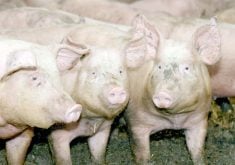A large bale of hay sold for $175 at Ponoka, Alta., last week,
indicating to many producers that feeding cows is becoming a losing
proposition this month.
That has sparked a major cow sell off that may ripple through the
industry for years to come.
The Ponoka auction saw 3,000 head arrive in one day from
drought-ravaged areas of Alberta.
The July 3 sale saw 750 dry cows going to slaughter for about 50 cents
a pound and 800 cow-calf pairs selling between $1,000 and $1,400.
Read Also

The Western Producer Livestock Report – October 2, 2025
Western Producer Livestock Report for October 2, 2025. See U.S. & Canadian hog prices, Canadian bison & lamb market data and sale insight.
“Too many cows are coming to town,” said Blair Vold, president of Vold,
Jones & Vold Auction. “You can’t feed cattle for that price or you’ll
go broke. You can’t feed your way out of a drought.”
Vold said the average price range was $85 to $110 for hay from the
British Columbia interior and parts of the Peace River region.
Phones are ringing off the hook at auction markets across northern and
central Alberta, as well as yards in northern Saskatchewan, where an
unprecedented drought is threatening the livelihood of producers.
Auctions are reporting three to four times normal sales volume for this
time of year.
At the Nilsson Bros. auction barn in Clyde, Alta., sales managers have
decided to schedule a cow sale every Thursday for the next six weeks.
“We’ll sell till they run out of cows or till it rains,” said market
manager Sheldon Wilcox.
Nilsson Bros. owns auction markets from Grande Prairie, Alta., to
Brandon.
People are culling much earlier and getting rid of non-productive older
cows that would have been sold in the fall.
“As we go further into the drought, we’re going to cut into the
youthful part of the herd,” Wilcox said.
“These are young and productive cows and they are going to be
introduced into other cow herds.”
As much as 20 percent of the herd may disappear across central and
northern Alberta, which may take five years to recover.
“It will have implications for land prices, implement dealers in town,”
Wilcox said.
Most of the cows coming to the auctions are in good condition, although
some herds have arrived thin.
More bulls than normal have also walked through the ring. Some might
have gone to market in the fall, but with widespread feed shortages,
they have been culled early.
Wilcox and Vold do not think fall feeder sales are going to be greatly
affected, but traditional cattle cycle patterns will be altered. Rather
than keep calves over the winter, more producers are expected to sell
in the fall rather than early spring.
“Over the course of the next six months we could market 80 percent of
the feeder cattle that we would normally market in the next 10 months,”
Wilcox said.
Anne Dunford of Canfax said cow beef prices have been fallen, but
premiums are still available for top-end cows.
Thirty-three percent more cows were sold for slaughter from April to
mid-June than were sold in the same period last year. Some pairs have
been sold as far away as Quebec.
“The auction markets have done a good job in finding buyers for these
cows at this time of year,” Dunford said.
As more females are culled or put on feed, calf shortages become a
factor and buyers are less likely to pay the record high prices seen in
fall 2001.
Dunford said a major cow sell off is also happening in drought-stricken
areas of Colorado and Wyoming.

















